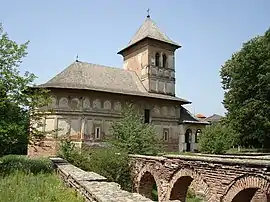Strehaia
Strehaia (Romanian pronunciation: [streˈhaja]) is a town in Mehedinți County, Oltenia, Romania. It is situated 25 km west of Filiași, on the Motru River valley. Forests in the vicinity are home to the largest Herman's tortoise colonies in Oltenia.
Strehaia | |
|---|---|
 Strehaia Monastery | |
 Location in Mehedinți County | |
 Strehaia Location in Romania | |
| Coordinates: 44°37′20″N 23°11′50″E | |
| Country | |
| County | Mehedinți |
| Government | |
| • Mayor | Ioan Giura[1] (PSD) |
| Area | 108.64 km2 (41.95 sq mi) |
| Population (2011)[2] | 10,506 |
| • Density | 97/km2 (250/sq mi) |
| Time zone | EET/EEST (UTC+2/+3) |
| Vehicle reg. | MH |
Nine villages are administered by the town: Ciochiuța, Comanda, Hurducești, Lunca Banului, Menți, Motruleni, Slătinicu Mare, Slătinicu Mic and Stăncești.
Demographics
At the 2011 census, the town had a population of 9,837. Of these, 88.79% were Romanians and 11.11% Roma; 99.4% were Romanian Orthodox.
History
| Year | Pop. | ±% |
|---|---|---|
| 1930 | 7,870 | — |
| 1948 | 7,776 | −1.2% |
| 1956 | 8,545 | +9.9% |
| 1966 | 9,768 | +14.3% |
| 1977 | 11,271 | +15.4% |
| 1992 | 12,324 | +9.3% |
| 2002 | 12,564 | +1.9% |
| 2011 | 9,837 | −21.7% |
| Source: Census data | ||
Strehaia was first mentioned in documents of the 15th century. As an alternative location for the residence of Oltenian Bans during the early Craiovești rules, the town still features the foundation of the Banate estate house; it had replaced Severin due to frequent Ottoman attacks, and was in turn replaced by Craiova, remaining a largely rural locality.
The Monastery of Strehaia was built by Wallachian Prince Matei Basarab in 1645. In 1671, a cattle fair was organized in the town, a regular event which contributed to the town's development. Strehaia was the site of skirmishes between the Pandurs of Tudor Vladimirescu and troops loyal to Scarlat Callimachi, during the Wallachian uprising of 1821.
The estates of Prince Antoine Bibesco were located near Strehaia.
Natives
- Rodion Cămătaru (born 1958), footballer
- Nicolae Popescu (1937–2010), mathematician
References
- "Results of the 2016 local elections". Central Electoral Bureau. Retrieved 3 April 2020.
- "Populaţia stabilă pe judeţe, municipii, oraşe şi localităti componenete la RPL_2011" (in Romanian). National Institute of Statistics. Retrieved 4 February 2014.
| Wikimedia Commons has media related to Strehaia. |
